Winter can be hard on your plants, but don’t worry! We’ve found 20 low-maintenance houseplants that will do great in your home during the cold months. These easy-to-care-for plants are perfect for brightening your space and making you feel better when it’s dark and cold outside.
Our list includes plants like the forgiving Chinese Evergreen and the tough ZZ Plant. They’re great for every corner of your home. These plants can handle low light, dry air, and even a little neglect. They’re perfect for busy people or those new to indoor gardening in winter.
Are you ready to make your home a cozy, green oasis this winter? Let’s explore our top picks for low-maintenance houseplants that will keep your indoor garden looking great all season.
Key Takeaways
- 85% of recommended plants prefer bright indirect light
- Low-maintenance houseplants typically need watering weekly to bi-weekly
- 75% of suggested plants are safe for homes with pets and children
- Succulents make up 30% of the recommended winter indoor plants
- The average height of suggested plants is 8 inches
- ZZ plants and snake plants are highly tolerant of dry winter air and low light
- Flowering plants like moth orchids and Christmas cacti add color to winter indoor gardens
Introduction to Winter Indoor Gardening
Winter can be tough for plant lovers. Cold weather makes many turn to indoor gardening. This not only brightens up homes but also has many benefits during the cold season.
Benefits of houseplants during winter months
Indoor plants clean the air, making your home healthier. They bring nature inside, lifting your mood and cutting stress. Some hardy indoor plants do well in winter, so you can enjoy them all year.
Challenges of winter plant care
Winter brings challenges for plants. Low light and dry air from heaters can stress them out. Most houseplants grow little or not at all in winter. They need less water and no food. Plants near windows or heaters can also be harmed by temperature changes.
Characteristics of low-maintenance houseplants
For winter, pick plants that don’t need much care and can handle different light. These plants fight off pests and diseases well. They’re perfect for indoor gardening in winter.
| Characteristic | Description | Example Plants |
|---|---|---|
| Light Tolerance | Adapts to low light conditions | Snake Plant, ZZ Plant |
| Water Needs | Requires less frequent watering | Succulents, Pothos |
| Temperature Resilience | Withstands temperature fluctuations | Spider Plant, Rubber Plant |
| Humidity Tolerance | Thrives in dry indoor air | Aloe Vera, Chinese Evergreen |
Chinese Evergreen: A Forgiving Beauty
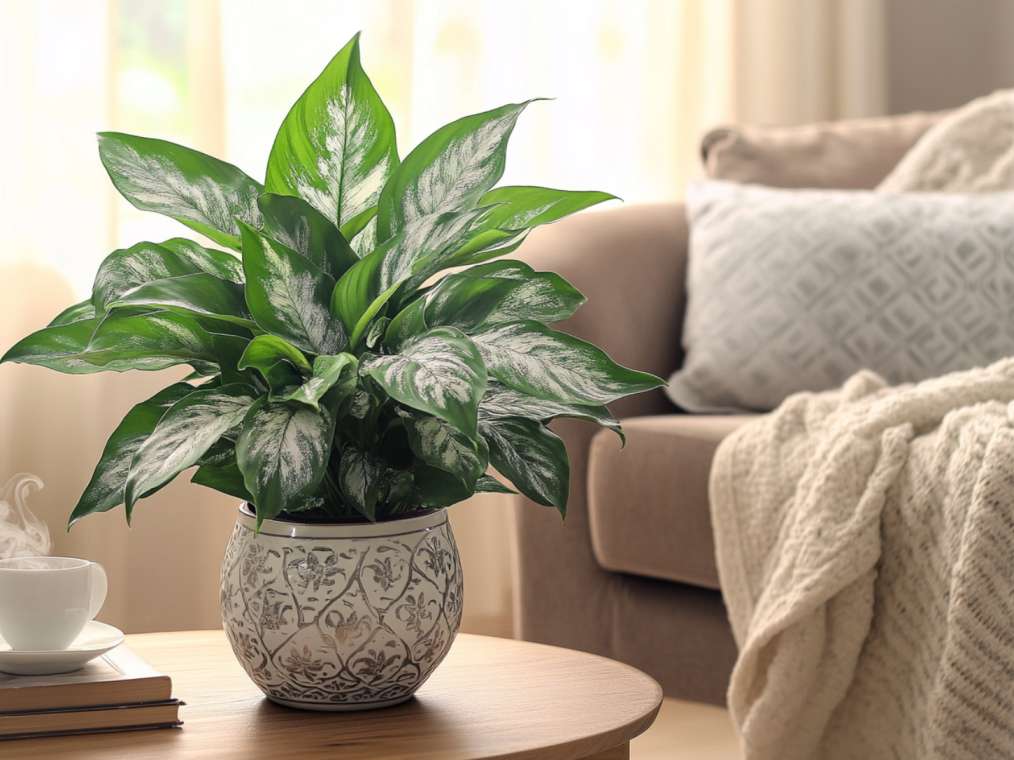
Chinese Evergreen (Aglaonema commutatum) is a great choice for beginners in houseplants. It does well in low light, ideal for indoor gardens during winter. This plant grows slowly, reaching 1 to 3 feet tall and wide.
This plant is easy to care for. It likes temperatures between 65-80°F and humidity of 60-70%. Water it when the top 2 inches of soil are dry. Use a potting mix that drains well and has an acidic pH of 5.5 to 6.5.
Chinese Evergreen comes in many varieties to match your style. You can choose from ‘Silver Bay’, ‘Maria’, ‘Red Siam’, and ‘Sparkling Sarah’. These plants have beautiful leaves in various colors, making your indoor garden look great.
To keep your Chinese Evergreen healthy, feed it monthly in spring and summer with a balanced fertilizer. Repot it every 2-3 years to help it grow. With little care, this plant will make your space beautiful for many years.
| Care Aspect | Requirement |
|---|---|
| Light | Low to bright indirect |
| Temperature | 65-80°F |
| Humidity | 60-70% |
| Watering | When top 2 inches of soil are dry |
| Soil pH | 5.5-6.5 |
ZZ Plant: The Ultimate Survivor
ZZ plants, or Zamioculcas zamiifolia, are top picks for Drought-Tolerant Houseplants. They come from South Africa and are known as Emerald palms or Eternity plants. This is because they can really last a long time.
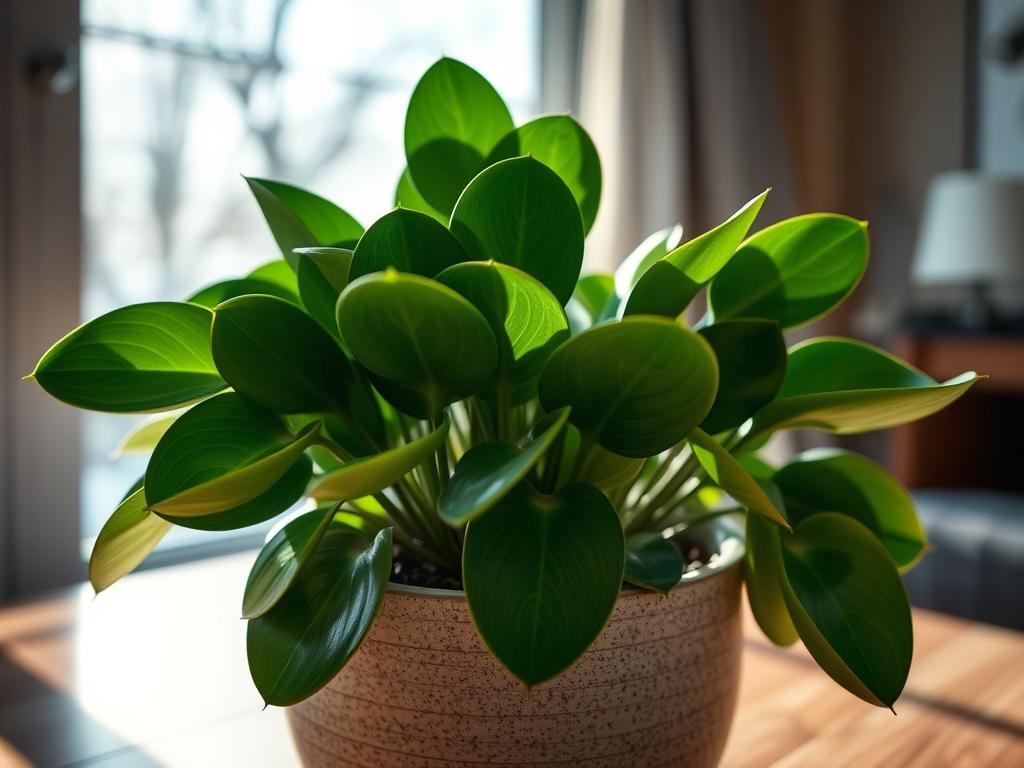
Drought-tolerant features
ZZ plants have thick, oval leaves with a waxy coating. This makes them look shiny and helps them survive tough times with little water. They usually need only two cups of water a week, depending on your home’s humidity.
Adaptability to low-light conditions
ZZ plants like bright, indirect sunlight but can adjust. They can grow well in many light conditions, from sunny to shady spots. This makes them great for places with less sunlight in winter.
Care tips for ZZ plants
To keep your ZZ plant happy:
- Use well-draining soil to prevent root rot
- Maintain temperatures between 65-75°F
- Clean leaves easily thanks to their waxy coating
- Consider a humidifier in dry winter months
| Feature | Benefit |
|---|---|
| Drought tolerance | Survives periods of neglect |
| Low light adaptation | Thrives in various home settings |
| Air purifying | Improves indoor air quality |
| Minimal care needs | Ideal for busy plant owners |
Snake Plant: Architectural and Air-Purifying
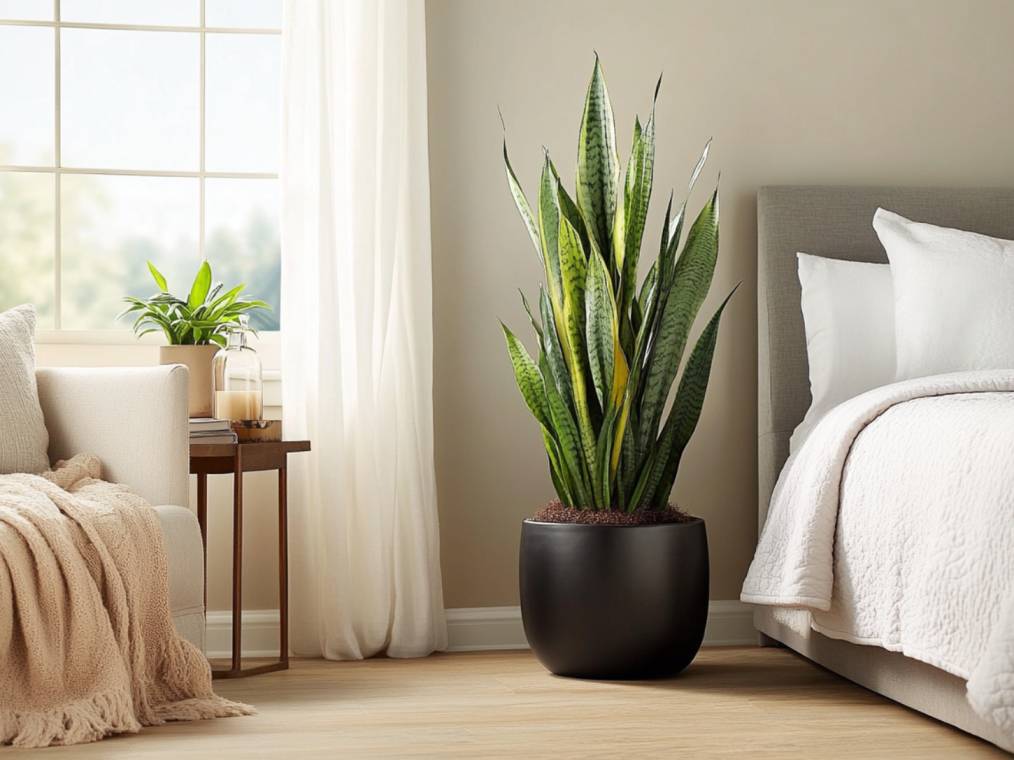
Snake Plants are great for indoor gardeners who want low-maintenance, air-purifying plants. They have striking leaves that look like blades, adding elegance to any room. These plants can grow to be 2 to 4 feet tall, fitting well in different room sizes.
Snake Plants are great for low-light spots. They do well in moderate to bright indirect sunlight but can handle just a few hours of direct light. This makes them perfect for offices, bedrooms, or areas with little natural light.
These plants are top air purifiers, removing harmful toxins like formaldehyde and benzene from the air. They are easy to care for, making them great for busy people or beginners in gardening.
Caring for your Snake Plant is easy:
- Water every 2 to 8 weeks, letting the soil dry out between waterings
- Repot every 3 to 5 years
- Fertilize a little during the growing season
There are over 70 species of Snake Plants to pick from, like “Laurentii,” “Moonglow,” or “Golden Hahnii.” Choose one that fits your style. But remember, these plants are toxic to pets if eaten, so keep them away from curious animals.
Pothos: Versatile and Fast-Growing
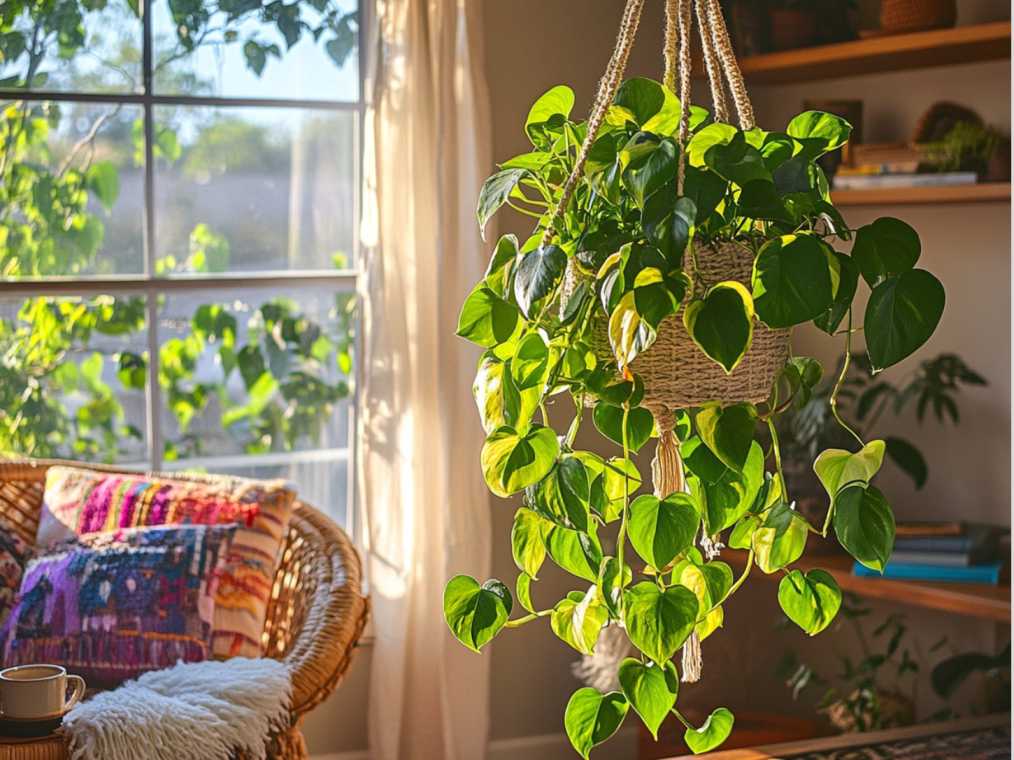
Pothos is a top pick for those new to indoor plants. It’s adaptable to many indoor settings, making it great for both beginners and seasoned gardeners.
Different Varieties of Pothos
Pothos has many beautiful types, each with its own look:
- Golden Pothos: Features green leaves with yellow variegation
- Marble Queen: Slow-growing with heavily variegated white and green leaves
- N’Joy: Compact variety with distinctive variegated foliage
Light Requirements and Watering Needs
Pothos does well in Low-Light Plants settings. It likes bright, indirect light but can handle low light. Water it when the top inch of soil is dry, which is usually every 1-2 weeks. These plants prefer high humidity, just like their tropical roots.
Propagation Techniques
Propagating pothos is easy and fun. Cut a 4-6 inch stem with leaves, take off the lower leaves, and put it in water. Roots will start to grow in 1-2 months. When the roots are 1-2 inches long, move it to soil.
| Pothos Care Tips | Details |
|---|---|
| Light | Bright indirect to low light |
| Watering | Every 1-2 weeks, when top inch of soil is dry |
| Humidity | Above 40%, ideally 70% |
| Fertilizer | Balanced liquid fertilizer every 1-3 months |
| Growth Rate | Up to 12 inches per month in growing season |
Succulents: Windowsill Wonders
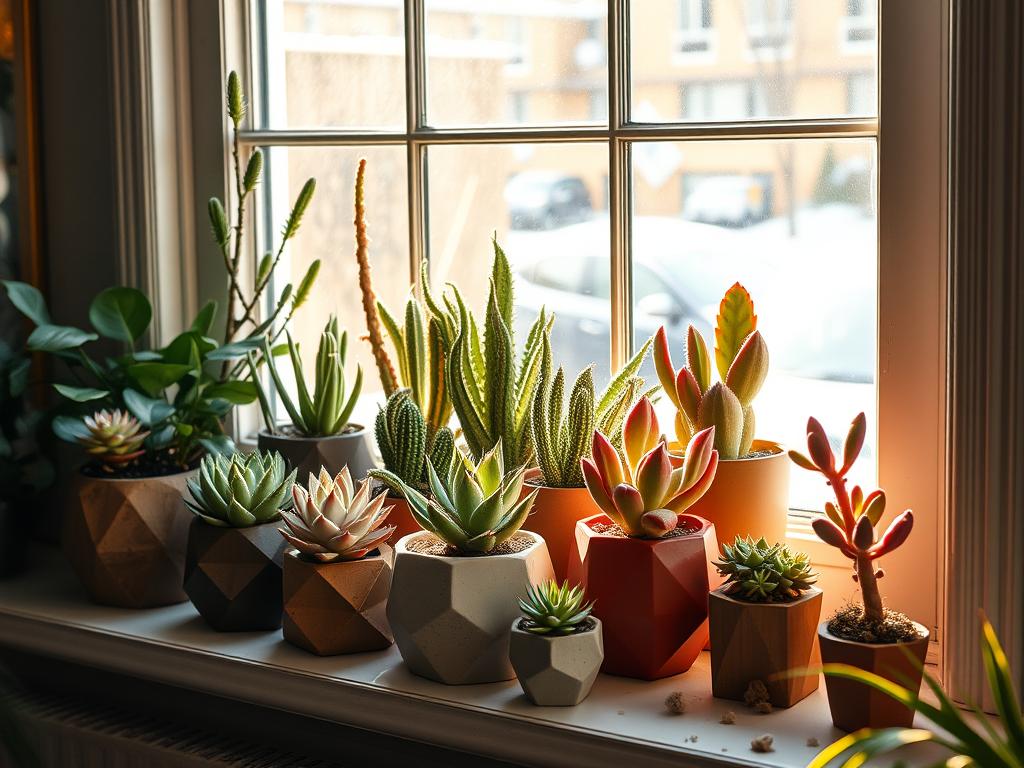
Succulents are ideal for winter plant care, especially for those who want drought-tolerant houseplants. They love dry indoor spaces and need little care. Their unique shapes and colors bring natural beauty to any room.
In winter, succulents go dormant. They need even less water. Water them just once a month. It’s better to underwater than overwater these tough plants.
Light is key for succulents. They like bright, indirect sunlight. Put them on a windowsill to catch winter sun safely. If their leaves turn red, they might be getting too much light.
- Echeveria: Known for its rosette shape and pastel colors
- Haworthia: Compact and perfect for small spaces
- Sedum morganianum: Thrives with sparse watering every 2-3 weeks
- Sempervivum tectorum: Features green leaves with burgundy edges
Feed your succulents once a month when they’re growing. In winter, they don’t need fertilizer. Watch out for big temperature changes, as they can harm their leaves. With these tips, your succulents will be beautiful all winter.
Low-Maintenance Houseplants for Winter Indoor Gardening
Winter can be tough for plant lovers. Picking the right plants makes it easier to care for them indoors. Let’s look at some easy-to-care-for houseplants for the cold season.
Selecting Plants for Different Light Conditions
Light levels change in winter. ZZ plants and snake plants do well in low light. Snake plants can handle dry conditions and fit into many spaces. For brighter areas, pothos comes in yellow, white, and green. English ivy works in low or medium light, making it flexible for various spots.
Watering Schedules for Winter Care
Change your watering habits for winter. ZZ plants need water every two to three weeks. Jade plants and ponytail palms can go without water for a while. Succulents like aloe vera, which can grow up to 3 feet tall, need little water. Most plants grow slower in winter, so they need less water.
Temperature Considerations for Indoor Plants
Keep indoor temperatures steady for healthy plants. Chinese evergreens do well in room temperatures and can get up to 3 feet tall. Philodendrons like indirect sunlight and can spread out, fitting easily into indoor spaces. For some color, try a Christmas cactus, which blooms in December or January.
By picking these hardy plants and caring for them right, you’ll have a beautiful winter garden. It will clean the air and make your home brighter.
Philodendron: Heart-Shaped Leaves for Every Space
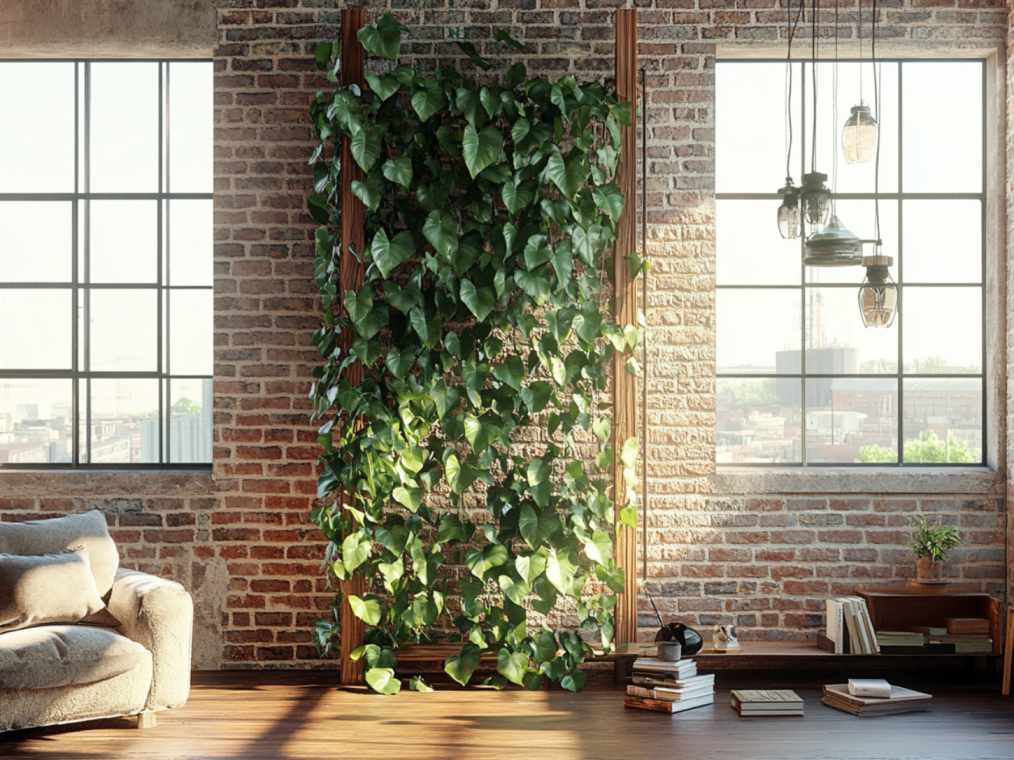
Philodendrons are great for those who want Low-Light Plants that are easy to care for. They have heart-shaped leaves that fit well in many indoor spots. There are hundreds of species, giving you lots of choices for your home.
These plants grow fast and can get quite big, up to 13 feet long. They do best in bright, indirect light but can handle low light too. They like soil that drains well and need water when the top inch of soil feels dry.
Here’s a quick guide to caring for your Philodendron:
- Light: Bright, indirect light
- Soil: Well-drained, soilless potting mix with peat moss
- Watering: Once a week, allowing soil to dry between waterings
- Humidity: 40% or higher
- Repotting: Every two to three years
Philodendrons are great at cleaning the air, making them a smart choice for your indoor garden. But, they can be harmful to pets and people, so keep them away from reach.
| Characteristic | Heart-Leaf Philodendron |
|---|---|
| Mature Size | 1-3 ft. wide, 3-13 ft. long |
| Hardiness Zones | 9a–11b (USDA) |
| Propagation Method | Rooting stem cuttings |
| Common Pests | Aphids, mealy bugs, scale, spider mites |
| Lifespan | Decades with proper care |
Philodendrons are perfect for both new and seasoned gardeners. They’re Low-Light Plants that are easy to care for. These plants will add a tropical feel to your home for many years.
Spider Plant: Easy Propagation and Air Cleaning
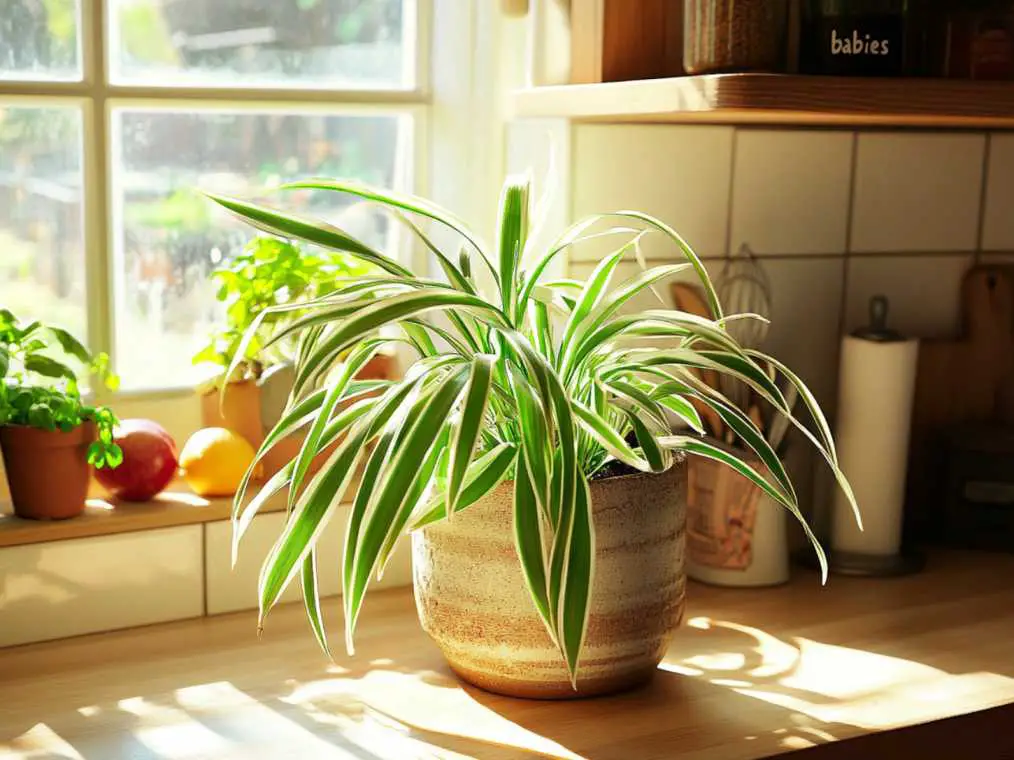
Spider plants, known as Chlorophytum comosum, are great for beginners. They grow 12-18 inches tall and 12-24 inches wide. This makes them perfect for many indoor spots.
They love bright, indirect light but can also live in lower light. This flexibility makes them easy to care for.
Varieties of Spider Plants
There are many types of spider plants, each with its own look:
- ‘Variegatum’: Features white stripes on green leaves
- ‘Vittatum’: Displays a white center stripe on green leaves
- ‘Milky Way’: Showcases cream-colored variegation
- ‘White Stripe’: Exhibits bold white stripes on dark green leaves
Propagating Baby Spider Plants
Propagating spider plants is easy. They grow small white flowers that turn into baby plants, or spiderettes. Here’s how to start them:
- Wait for the spiderette to develop roots
- Cut it from the parent plant
- Plant in a pot with well-draining soil
- Water regularly until established
Air-purifying Benefits
Spider plants are great at cleaning the air. They remove pollutants like:
| Pollutant | Removal Efficiency |
|---|---|
| Formaldehyde | High |
| Xylene | Moderate |
| Benzene | Moderate |
| Carbon Monoxide | Low |
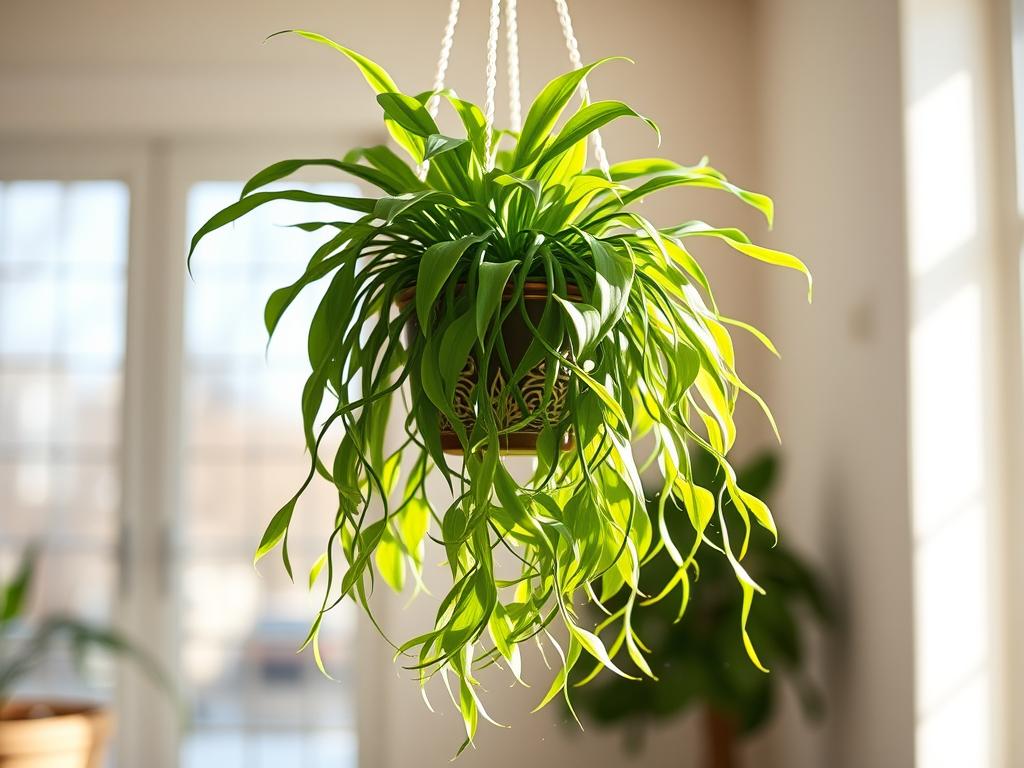
These plants like temperatures above 45°F and enjoy regular misting with distilled water. Water them when the top 2 inches of soil dry out, which is usually every 10-21 days. With a little care, they’ll flourish, making your air cleaner and adding green beauty to your space.
Rubber Plant: Glossy Leaves and Minimal Care
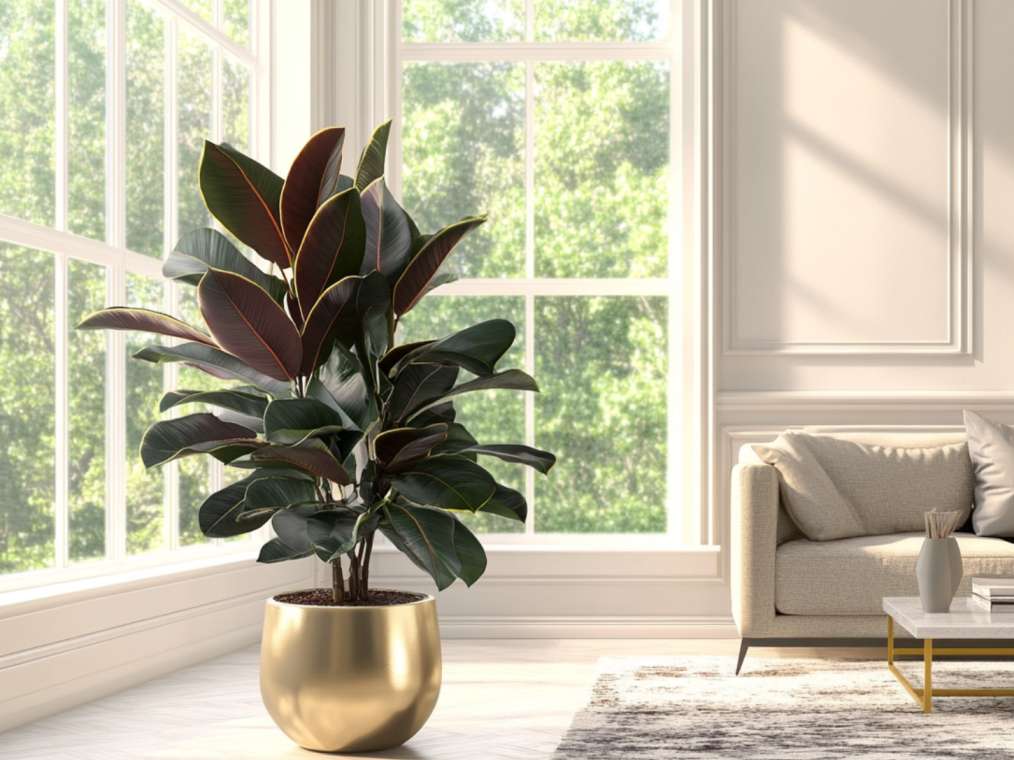
The Rubber Plant (Ficus elastica) is a stunning addition to your winter indoor garden. It has glossy leaves and needs little care, making it great for those who want easy-to-maintain houseplants. This plant can grow up to 6 to 10 feet tall indoors, becoming a beautiful centerpiece in any room.
Rubber Plants love bright, indirect light. Put yours a few feet from a window for the best growth. They do well in temperatures between 65°F and 85°F, which is common in most homes. They also don’t mind the humidity levels in most rooms.
Watering is easy: let the soil dry out before watering again. In winter, you’ll water less often. Feed it with a balanced liquid fertilizer every month in spring and summer. Don’t fertilize in fall and winter when it’s not growing as much.
- Repot every 2-3 years
- Prune occasionally to control height
- Wipe leaves to remove dust
Rubber Plants are usually pest-free, but keep an eye out for scale or mealybugs. If you find any, use neem oil or insecticidal soap to treat them. With the right care, your Rubber Plant will be a lasting, easy-to-care-for part of your indoor garden.
| Aspect | Requirement |
|---|---|
| Light | Bright, indirect (6-8 hours daily) |
| Temperature | 65°F – 85°F |
| Watering | When soil is almost dry |
| Fertilizing | Monthly (spring/summer) |
| Mature Height (Indoor) | 6-10 feet |
Aloe Vera: Practical and Pretty
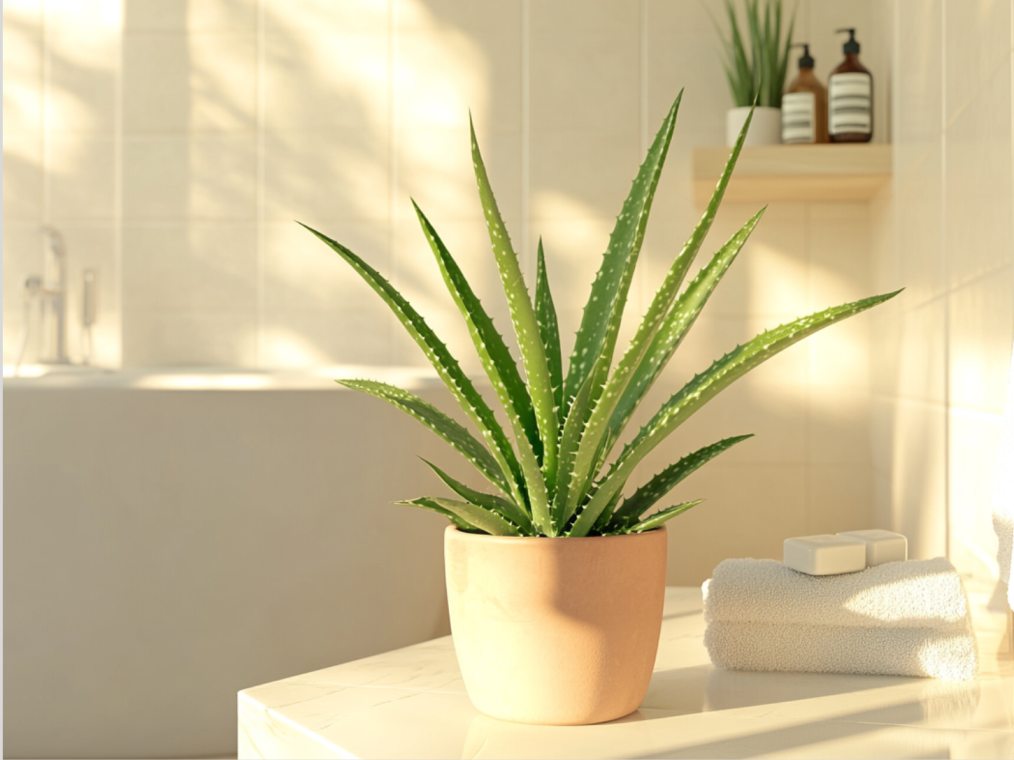
Aloe vera is a top choice for those who forget to water their plants. It’s both useful and beautiful. Its thick leaves store water and nutrients, ideal for busy people.
Place aloe vera in bright, indirect sunlight. It grows best in temperatures between 55°F and 85°F. With the right care, it can live for 10 to 20 years, becoming a long-lasting part of your home.
Watering aloe vera is easy. Wait for the soil to dry out before watering again. In summer, water every two weeks, and less in winter. Too much water can cause root rot, so be careful.
Aloe Vera Care Tips
- Use sandy or gravelly, free-draining soil
- Fertilize once a year at the start of growing season
- Watch for pests like mealybugs and mites
- Trim brown leaf tips as needed
Aloe vera is not only beautiful but also useful. You can take gel from its leaves for many uses. As it grows, it produces pups – small plants that you can move to new pots.
| Feature | Description |
|---|---|
| Size | 2-3 feet tall and wide |
| Sunlight Needs | 6-8 hours of full sun (outdoors) |
| Watering Frequency | Every 2 weeks in summer, less in winter |
| Maturity | 3-4 years |
| Flowering | After 4-5 years |
Peace Lily: Elegant Blooms with Low Light Tolerance
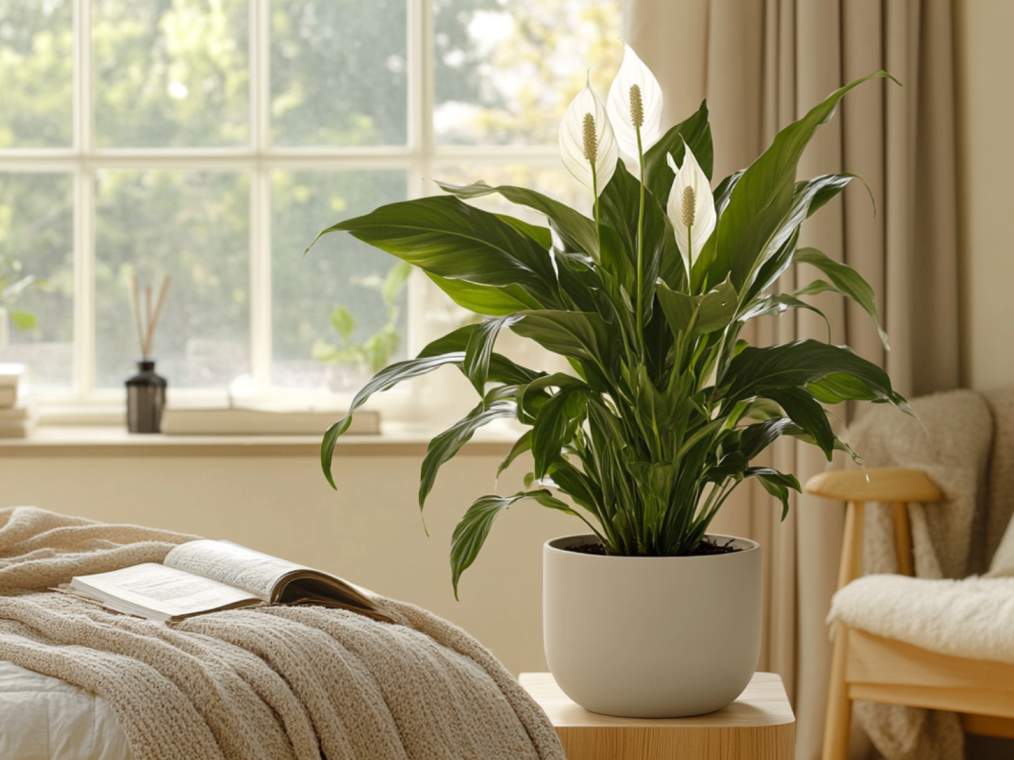
Peace lilies are elegant air-purifying plants that do well in low light. They add sophistication to any room and help clean the air. These houseplants are versatile and easy to care for.
Flowering Habits of Peace Lilies
Peace lilies are known for their beautiful white flowers. They can grow from 1 to 6 feet tall. The “Sensation” variety often grows taller than others.
These plants bloom in spring but can flower more times a year with the right care.
Watering and Light Requirements
Peace lilies like soil that’s a bit moist but can handle various light levels. They do best in medium light but can also live in low-light spots. Don’t overwater, as this can turn their leaves yellow.
Let the soil dry out a bit before watering again. This keeps your peace lily healthy and happy.
Air-Purifying Qualities
NASA research highlights peace lilies as great at removing toxins from the air. They get rid of benzene, ammonia, and formaldehyde. This makes them ideal for improving indoor air quality during winter.
They are easy to care for, making them perfect for both new and experienced gardeners. Plant owners love them for their ability to purify the air.
FAQ
What are the benefits of having houseplants during winter?
Houseplants brighten up the long winter days, especially in cold, snowy areas. They also clean the air and boost mood.
What are the challenges of caring for houseplants in winter?
Caring for houseplants in winter is tough because of less daylight, changing temperatures, and dry air from heaters.
What characteristics make a houseplant low-maintenance?
Low-maintenance houseplants can handle neglect, adjust to different light, and fight off pests and diseases easily.
What makes the Chinese evergreen (Aglaonema commutatum) a good choice for winter indoor gardening?
The Chinese evergreen is easy to care for with its beautiful, patterned leaves. It does well in low light and can handle inconsistent watering, perfect for beginners.
Why is the ZZ plant (Zamioculcas zamiifolia) considered virtually indestructible?
The ZZ plant is tough because it can survive in low light and only needs water now and then. Its leaves are thick and don’t easily turn brown.
What are the benefits of having a snake plant (Sansevieria trifasciata) indoors?
Snake plants add beauty with their unique leaves in different colors and patterns. They handle low light, drought, and neglect well, and clean the air.
Why is pothos (Epipremnum aureum) a versatile choice for winter indoor gardening?
Pothos is versatile and grows quickly, coming in many types. It does well in low light and can survive with less water.
What makes succulents ideal for dry winter environments?
Succulents are perfect for dry winter times and look great on windowsills. They come in many colors and styles, need little water in winter, and add a unique touch to any space.
What factors should be considered when selecting low-maintenance houseplants for winter?
When picking houseplants for winter, think about how much light they need, how often they should be watered, and what temperature they like. Some plants do well in low light, while others prefer bright, indirect light. Adjust their care to keep them healthy.
What makes philodendrons, such as the heart-leaf philodendron (Philodendron hederaceum), a good choice for winter indoor gardening?
Philodendrons are adaptable with shiny, heart-shaped leaves. They can handle low light and don’t mind if you forget to water them, making them great for any indoor spot.
Why are spider plants (Chlorophytum comosum) popular choices for indoor gardening?
Spider plants are easy to grow and clean the air. They produce baby plants that are simple to spread around.
What are the benefits of having a rubber plant (Ficus elastica) indoors during winter?
Rubber plants have big, shiny leaves and are easy to care for. They can live in low light and only need water sometimes, making them perfect for winter.
What makes aloe vera a practical and attractive choice for winter indoor gardening?
Aloe vera is both useful and pretty, surviving on little care. It stores water in its leaves, so it only needs water sometimes. Plus, its gel can soothe skin.
Why are peace lilies (Spathiphyllum) a good choice for winter indoor gardening?
Peace lilies are elegant and easy to care for, doing well in low light and flowering beautifully. They clean the air, making them great for improving indoor air quality in winter.
